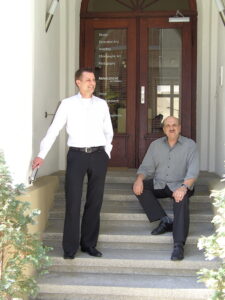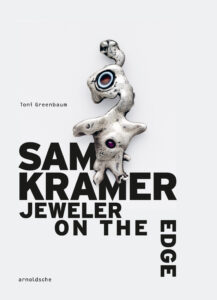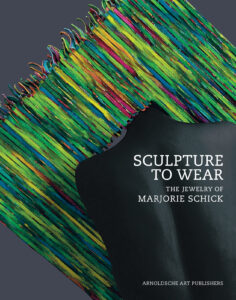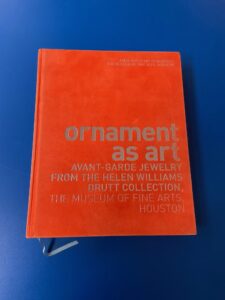Episode 204
What you’ll learn in this episode:
- How Arnoldsche collaborates with authors to create an effective design for each book
- What young artists should know before trying to publish a book
- How Dirk keeps tabs on trends and new developments in jewelry and decorative arts
- How Arnoldsche selects the right markets and languages for its books
- Why the art book market has changed dramatically over the last 10 years, and how Arnoldsche has adapted
About Dirk Allgaier:
Since April 2015, Dirk Allgaier has headed Arnoldsche Art Publishers, an internationally active publisher of art books that offers a unique list of titles in the fields of fine art, applied art and design. With great expertise, sheer hard work and a passion for his profession, he and his team ensure that books from Arnoldsche become what they are: high-quality, individually designed publications and book objects that transport the broad range of creative endeavor in all its diversity across the globe.
Additional Resources:
- Arnoldsche Art Publishing’s Website
- Arnoldsche Art Publisher’s Instgram
- Arnoldsche Art Publisher’s X/Twitter
Photos:
Dieter Zühlsdorff, founder of Arnoldsche Art Publishers, with Dirk Allgaier, (Dirk Standing)


Cover of the publication “Sculpture to Wear. The Jewelry of Marjorie Schick”, published 2007

Cover of the publication “Ornament as Art. Avant-Garde Jewelry from the Helen William Drutt Collection, The Museum of Fine Arts, Houston”, published 2007

Transcript:
No other publishing house in the world has published as many books on jewelry, ceramics and other applied arts as Arnoldsche Art Publishing. Led by Dirk Allgaier, Arnoldsche is the go-to source for anyone who wants to learn more about the decorative and applied arts, the people who create them, and the museums that exhibit them. Dirk joined the Jewelry Journey Podcast to talk about how he selects the 10 to 15 books Arnoldsche publishes each year; how he works with artists to create a beautiful and informative book; and why a language barrier doesn’t always prevent someone from reading an art book. Read the episode transcript here.
Sharon: Hello, everyone. Welcome to the Jewelry Journey Podcast. This is the second part of a two-part episode. If you haven’t heard part one, please head to TheJewelryJourney.com.
My guest is Dirk Allgaier of Arnoldsche Publishing. They’re art publishers, and if you have any kind of design library—and that includes jewelry, ceramics, monographs on artists, furniture and more—you no doubt have books that have been published by Arnoldsche. Welcome back.
Do you have people come that you haven’t heard of, but they have great expertise? Maybe they’re a professor or somebody else that has a lot of expertise in their area?
Dirk: I know our field quite well; it’s a small field, but it happens that people approach me and send me a suggestion for a new book project and I don’t know the artist. There’s always something new to discover. I say every book we are doing, not only in jewelry but also in ceramics or in wooden art, in metalware, in furniture, in textile, in glass, it opens a new window. It gives me a new prospectus to see new things which I did not know before. This is a reason why I like my job. I love my job very much.
It happened last year at the Art Jewelry Forum. Susan Cummins suggested to me to publish a book about Keith Lewis, the American jewelry artist. I really did not know his work. I read the manuscript in the evening when I was home. I was reading; I looked at the images. I was thinking, “That’s fantastic, what he did. It was the 1980s. He was so progressive. He was so political in that time, so important. Today what is he doing?” That was totally new, and now we are publishing his book. It’s designed. We are now doing the images. In about four weeks, we go to press for that book. So, it happens on the jewelry scene that artists are suggested to me, are recommended, which I do not know. But most artists, of course, I know more or less their work.
Sharon: Susan Cummins had brought you several books before this Keith Lewis one. Does that reflect? Did you take that into account when you were deciding?
Dirk: We met each other and decided to cooperate, to collaborate, because she has fantastic topics in jewelry. It’s very political, the book about Laurie Hall. It’s about Northwest American jewelry. We say in Germany it’s narrative jewelry. This kind of jewelry was not so well-known in Europe.
We have a very strong distribution. We sell our books worldwide, so we bring this topic through the book to an international audience, to the international market. It’s important for this American artist to be represented through the book internationally, so it’s a win/win situation. Susan has wonderful topics for publications. We produce the books and distribute them internationally. It’s a very good joint venture.
Sharon: You distribute them. I haven’t seen them in the States, I don’t think, except the Art Jewelry Forum books. I’m seeing those, but that’s it.
Dirk: We have a distributor in the United States. It’s ACC Art Books. Every book is stored in the United States in a warehouse, and we have representatives in the United States. You can go to a bookshop and order our books, but the books are such special books that they are only in special bookstores, mainly in museum bookstores, like the Metropolitan Museum or the Museum of Modern Art in New York.
The bigger bookstores and art bookstores have our books, but everything changed in the last 10, 15, 20 years. There are not so many bookshops left, so mainly art books are available online. This is an online trade. If you did a book about Sam Kramer, if you Google Kramer, you find immediately that you have to buy our book either on Amazon or on Book DE or on Instagram. You can order the book online. It’s really a change to selling books. 60% to 70% of books we are selling now online, not through bookstores.
Sharon: Does somebody come to the website and see a book they want?
Dirk: We have a web shop. You can order the book from our web shop. That’s also possible. Wherever you are living, you can order it. For example, when you are living in the United States, you can order it from the web shop, and our American partner or American distributor will send you the book within a short timeframe. Within three or four days, you will have the book.
Sharon: Now, some of your books are only in German.
Dirk: Yes.
Sharon: Since I don’t speak a word of German, what do you do? Do you have some in English and some in German and some half and half?
Dirk: It depends on the topic. We publish in many languages, but the main language is English. That’s definitive. English is very important, but there’s also German if it doesn’t have a major audience. Then it’s also a question of money or financing. There are translation codes, which are very extensive. You have to make an extra typesetting. You need more pages. You need more printing. Then we say, “O.K., we leave it only in German. We know we would not sell many copies in the English-speaking market, so we leave it in German.” But mainly the books are in English.
A few are only in German, but if the artist comes from another country, we also publish books, for example, in the French language, in Italian, in the Norwegian language, also in Estonian, in Catalan. We have two books in the Hebrew language, in Arabic and even in the Japanese language. It depends where the artist is living and in which country the topic is, and then we publish in different languages.
Sharon: Wow! The jewelry you mentioned, and in looking at your books, it’s so contemporary. Is that what you look for? It’s really unusual.
Dirk: Yeah, because for us, jewelry is art. There is no difference. It’s studio jewelry. It’s art jewelry. It’s like an art book. We have to publish jewelry books like an art book, and that’s very important. The style of the jewelry, its artistic value, is represented in the book, so the quality must be very high. You must see the high value of jewelry. You must see it in the book. That’s why it’s important for us.
Sharon: That’s interesting. So, you wouldn’t publish a book on “normal” jewelry.
Dirk: We do books about higher-range costume jewelry because they’re fantastic topics. In the 1920s in Germany, in the Art Deco period, there were companies who did articles of fantastic jewelry. Next year, we are planning a book about the New York jewelry designer Marcus & Co. So, we have books about art and costume jewelry, but not about the regular jewelry you can buy in a regular shop. This is not our interest.
Sharon: Have you ever started a book and then said, “Forget it. This is too complicated,” or “There’s not a market”?
Dirk: No, normally we don’t. If I start something, I bring it to an end. That’s very important for me, even if it’s very, very difficult. Usually, once we start on a book, we finish it. That’s very important. I remember a book we did 20 years ago. It was about an Italian topic, and everybody told me at the time, “You would never publish that book. You would never finalize it,” but we did it. That made me very proud; that we did this book finally. Every book we’ve started, we finished the book.
For me, it’s important to publish a book together with an artist or with a partner—the person is a partner for me—with a lot of mutual respect and to achieve a result which satisfies everybody: the publishing house, the artist, the museum. If we work together for three, four, five months, it’s like a partnership. You work very intensively together with an artist, and the results just have to be right. That’s very important. You put the book together; you celebrate; you’re happy. That’s how it should be, and that’s how it is, usually.
Sharon: Do you go to book trade shows where they have new books? I don’t know if they still have them. They used to have book trade shows.
Dirk: They had it some years ago, but there’s no big importance anymore. There are book fairs in Frankfurt, so we go to Frankfurt. 20 years ago, we went to the Chicago Book Fair, to the American Book Fair, to London, but we don’t do that so much. We have our books at the Schmuck in Munich, of course. You can buy them at the Schmuck Fair, or if there are special ceramic fairs, special jewelry events. We also have bookshops that go there. They have their stands there, and there are books at these events.
Sharon: I was looking online at your books. I noticed there were books about Babetto and I was surprised. None of it looked at the jewelry; they looked at the furniture and the drawings and things like that. What made you decide to do a second book on Babetto?
Dirk: The first book—I think it was the year 2009, 2010. Pinakothek der Moderne is a big museum, and every year during Schmuck, they have a big exhibition on the roof of the rotunda. Every year they show a different artist. They showed Thomas Gentille, for example, Anton Frühauf, Hermann Jünger, Peter Skubic. 15 years ago, they showed Giampaolo Babetto. We did a small but very special book on Giampaolo Babetto on the occasion of the exhibition. That was 2008, 2009.
Last year, Giampaolo asked, “Can you come to Italy? Can we meet? I’m planning a new book.” He planned a complete oeuvre catalogue of all his work in jewelry, in metalware, in architectural design, in religious pieces. So, we did an oeuvre catalogue. All his work from the beginning until 2022 is published in the book. Those are two different approaches. One was very personal for the exhibition, and this last was the catalogue about his work. It’s a total Babetto.
Sharon: That’s interesting. There didn’t seem to be that much jewelry in the Babetto books. It was more his other designs, his other things.
Dirk: One half of the book is jewelry. The other half is his metalworks, his furniture designs and the other things.
Sharon: For those who don’t know what Schmuck is, do you want to describe it?
Dirk: It’s an annual event in Munich on the occasion of the International Art and Crafts Fair. It’s an international trade fair for crafts and design. In 1959, it was founded by Herbert Hoffmann. It was a competition where contemporary jewelry was presented in a small part of the fair. That was the beginning over 60 years ago. It was a very small event, but every year it became bigger.
Now it’s still the Herbert Hoffmann Award, the Herbert Hoffmann Exhibition, but throughout the whole city, there are about 50, 60 galleries showing jewelry in contemporary galleries. They rent a space, they show jewelry, and they come from all over the world. It’s a huge event which lasts five days. You can see a lot of jewelry. You have gallery exhibitions. You have some museums that show jewelry. The Mesa is a big exhibition. The whole world of contemporary art jewelry, of studio jewelry, is in Munich.
Sharon: I’ve only been a couple of times, but I didn’t know Herbert Hoffmann was so integral in it. I know they have a prize.
Dirk: Yeah, the award. You can go online. You can look up the Herbert Hoffmann Award and see the prize winners from 1959. You read these names, and it’s really the top of the top of international jewelry artists. It’s very interesting to read the award winners of the Herbert Hoffmann Prize.
Sharon: Wow! I didn’t know it was so old, either. These people, the authors who want to write a book or a museum, do they have the person in mind who’s going to put the book together? Do they have the illustrator? Do they have the photographer in mind, or do they let you decide?
Dirk: It’s important if you write a book to have photographs available. Every artist has an archive of photographs, and every artist’s archive is different. Some have a very accurate archive with good photographs, and they know exactly what goes into the books. Some other artists have only images or older slides. Here we can be of help. We can make sense of old photographs. Usually, an artist has photographs for the book and they know which pieces should go into the book, but often I sit together with artists and we go through the materials, through the pieces. For an artist, it’s often difficult to make a decision, to take this piece or that piece. Then we sit together and say, “It’s that piece and not that.”
Photography is very important. An artist can have a designer, or we have the designer and we do image editing for the images. We do printing, and then we include the book in our book program, into our publishing list. Then we send the book worldwide on our list. This is the way.
Sharon: What country are most of your sales in? I don’t know if it’s Germany or Switzerland or Austria.
Dirk: We are selling one-third of our books in German-speaking countries, in Germany, Switzerland and Austria. They still have a strong market for art books and for jewelry books. Two-thirds we sell outside the German-speaking countries. England is a very important market. Scandinavia buys our books, and, of course, the American market is important for us. We sell books in China. We have one representative and he’s Chinese. There are big distributors in China, so we are sending books to the distributors, and they are selling the books to the individual bookstores and individual customers in the country. Japan is very difficult to sell books. South Korea is an important market for us. We sell some books in Australia as well, but I can say Germany, England, America and China. These are very important markets for us.
Sharon: If somebody doesn’t speak the language—I’m thinking of myself—do you just look at the pictures? What do you do?
Dirk: There’s a society of booksellers here in Germany. They made a test with people. They asked a thousand people, “What are you doing when you buy a book with images such as an art book? What are you doing with the book? Do you read it? Do you look at images?” They found out that only 10% of the book buyers are reading a book. 90% are looking at the images and reading here and there a little bit, but almost nobody is reading a book from the beginning to the end.
Sharon: I don’t feel so bad because I look at the pictures. What languages have you thought about? Have you thought about French? Are there other languages you’ve thought about putting your books in?
Dirk: I think English and German are the most important. In France, it’s difficult to sell books because the market is very small. When we have a French artist, of course we publish the book in French, but if the artist is not French, we don’t publish a book in the French language. It’s a small market. The book trade market is quite difficult, so the artist should be French-speaking, and then you publish it in French.
I would like to publish a book in the Chinese language, in Mandarin, because we didn’t do this yet. We have a book about New Zealand artists coming in two years, and it would be wonderful to have at least one essay in M?ori, in the native language of New Zealand. That would really be a task for me to do, but it would appreciate the First Nations people of the country.
Sharon: Any other plans besides other languages? What are your plans besides the books in production? What else would you like to do?
Dirk: Generally, for me it’s important that every half-year we have a catalogue. All our new books are featured in a catalogue which we send out every half-year. So, for me, the most important challenge is to have a good program to find newer catalogues which I present to people every half-year. This is the most important.
And to find a place for our special books, because it’s not easy to find places. It’s a niche program to find readers, to find people who buy the books and to find new people who did not know anything about artistic jewelry or studio jewelry. So, to find new people to bring a fascination for art into the world and to find new friends, new people who really love our work. That’s the most important thing for me.
Sharon: I hope that you do. Thank you so much for being with us today. I really appreciate it.
Dirk: Thank you very much, Sharon. Thank you.
Sharon: We will have photos posted on the website. Please head to TheJewelryJourney.com to check them out.
Thank you again for listening. Please leave us a rating and review so we can help others start their own jewelry journey.

